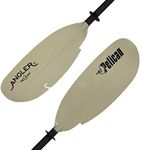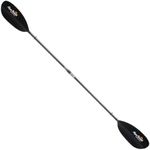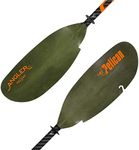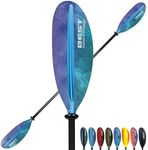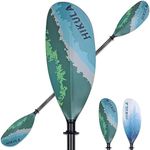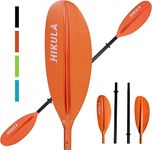Buying Guide for the Best Fishing Kayak Paddles
Choosing the right fishing kayak paddle is crucial for ensuring a comfortable and efficient paddling experience. The right paddle can make a significant difference in your ability to maneuver your kayak, maintain speed, and reduce fatigue during long fishing trips. When selecting a paddle, consider factors such as your height, the width of your kayak, and the type of water you'll be navigating. Here are some key specifications to consider when choosing a fishing kayak paddle and how to determine the best fit for your needs.LengthThe length of the paddle is important because it affects your paddling efficiency and comfort. A paddle that is too short will require more effort to reach the water, while a paddle that is too long can be cumbersome and difficult to control. Paddle lengths typically range from 210 cm to 260 cm. If you have a wider kayak or are taller, you may need a longer paddle. Conversely, if you have a narrower kayak or are shorter, a shorter paddle may be more suitable. To find the right length, consider your height and the width of your kayak, and refer to sizing charts provided by manufacturers.
Blade ShapeBlade shape affects the paddle's performance and efficiency in the water. There are two main types of blade shapes: high-angle and low-angle. High-angle blades are shorter and wider, designed for more aggressive paddling and better suited for faster, more powerful strokes. Low-angle blades are longer and narrower, ideal for a more relaxed paddling style and better suited for long-distance paddling. Choose a blade shape based on your paddling style and the type of water you'll be fishing in. If you prefer a faster pace and more control, a high-angle blade may be best. If you prefer a leisurely pace and longer trips, a low-angle blade may be more suitable.
MaterialThe material of the paddle affects its weight, durability, and cost. Common materials include aluminum, fiberglass, and carbon fiber. Aluminum paddles are the most affordable and durable but are also the heaviest. Fiberglass paddles offer a good balance of weight and durability, making them a popular choice for many kayakers. Carbon fiber paddles are the lightest and most efficient but are also the most expensive. Consider how often you'll be using the paddle and the conditions you'll be paddling in. If you plan on frequent, long trips, investing in a lighter paddle like fiberglass or carbon fiber may be worth it to reduce fatigue.
Shaft DesignThe design of the paddle shaft can impact your comfort and paddling efficiency. There are two main types of shaft designs: straight and bent. Straight shafts are the most common and offer a traditional feel, while bent shafts have a slight angle that can reduce strain on your wrists and improve paddling efficiency. Some paddles also feature adjustable shafts, allowing you to customize the length and feathering angle. Consider your comfort and any potential strain on your wrists when choosing a shaft design. If you experience wrist discomfort, a bent shaft or adjustable paddle may be a better option.
FeatheringFeathering refers to the angle of the paddle blades in relation to each other. Paddles can be feathered or unfeathered. Feathered paddles have blades set at an angle to reduce wind resistance and improve paddling efficiency, while unfeathered paddles have blades aligned with each other. Many paddles offer adjustable feathering angles, allowing you to customize the angle to your preference. If you often paddle in windy conditions, a feathered paddle can help reduce fatigue. If you prefer a simpler design, an unfeathered paddle may be more suitable.

